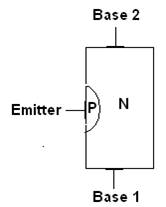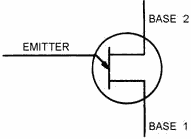Unijunction Transistor (UJT)
Electronic devices are mainly used in switching. BJT acts as a switch and is very simplest method but it has low efficiency and many faults. Therefore UJT and SCR are more useful in electronic circuit for switching purpose. It has high impedance in OFF condition and low impedance in ON condition. A unijunction transistor (UJT) is a three lead semiconductor device with only one junction that acts exclusively as an electrically controlled switch. The UJT is used in free running oscillators, synchronized or triggered oscillators and pulse generation circuits at low to moderate frequencies. It is widely used in triggering circuits for silicon controlled rectifiers.
Constructions of UJT:
Unijunction transistor is a three terminal, single junction, two layered device, and it is similar to a thristor. It consist of a lightly doped Si bar with heavily doped P- type material. P type material is attached to N type firmly and produced a single P-N junction. Emitter is nearest to base2 than base1.
Vb1 > Vb
UJT has three terminals which are called san emitter (E), base1 (B1) and base2 (B2).
Emitter is formed by P type material and B1 and B2 are formed by N type Si bar.
Emitter arrow indicates emitter current (IE) direction and emitter connection is shown at an angle to the vertical line.



